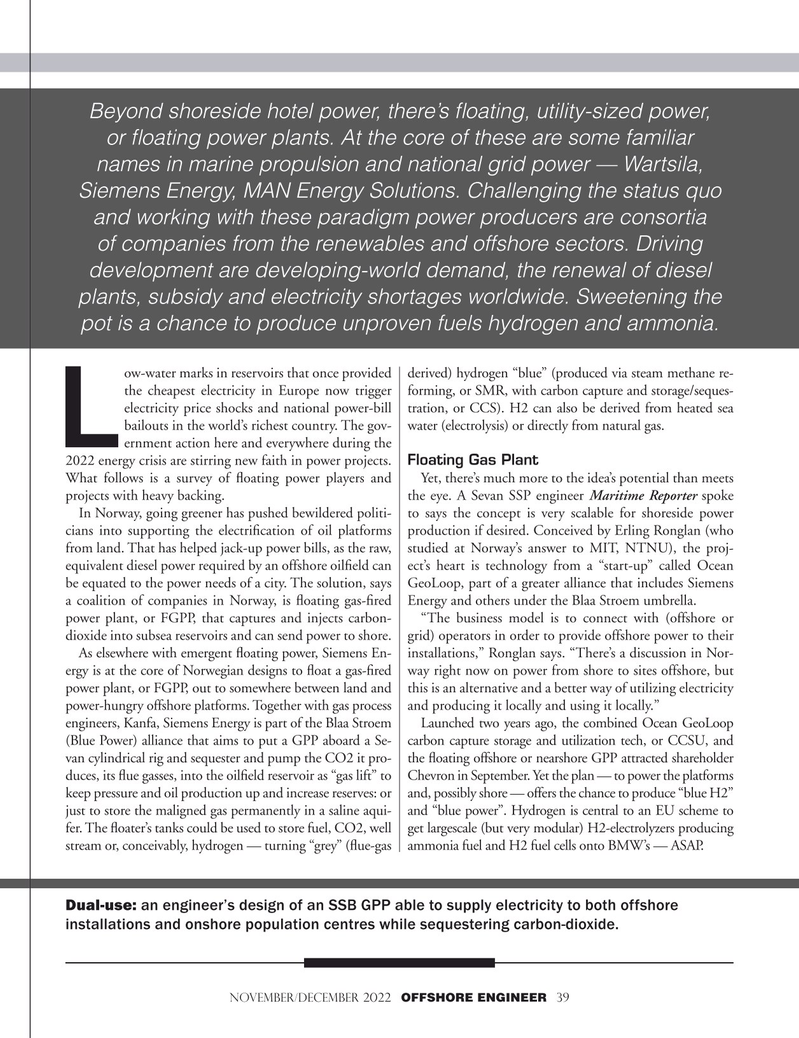
Page 39: of Offshore Engineer Magazine (Nov/Dec 2022)
Read this page in Pdf, Flash or Html5 edition of Nov/Dec 2022 Offshore Engineer Magazine
Beyond shoreside hotel power, there’s ?oating, utility-sized power, or ?oating power plants. At the core of these are some familiar names in marine propulsion and national grid power — Wartsila,
Siemens Energy, MAN Energy Solutions. Challenging the status quo and working with these paradigm power producers are consortia of companies from the renewables and offshore sectors. Driving development are developing-world demand, the renewal of diesel plants, subsidy and electricity shortages worldwide. Sweetening the pot is a chance to produce unproven fuels hydrogen and ammonia.
ow-water marks in reservoirs that once provided derived) hydrogen “blue” (produced via steam methane re- the cheapest electricity in Europe now trigger forming, or SMR, with carbon capture and storage/seques- electricity price shocks and national power-bill tration, or CCS). H2 can also be derived from heated sea bailouts in the world’s richest country. The gov- water (electrolysis) or directly from natural gas. ernment action here and everywhere during the
L 2022 energy crisis are stirring new faith in power projects. Floating Gas Plant
What follows is a survey of ?oating power players and Yet, there’s much more to the idea’s potential than meets projects with heavy backing. the eye. A Sevan SSP engineer Maritime Reporter spoke
In Norway, going greener has pushed bewildered politi- to says the concept is very scalable for shoreside power cians into supporting the electri?cation of oil platforms production if desired. Conceived by Erling Ronglan (who from land. That has helped jack-up power bills, as the raw, studied at Norway’s answer to MIT, NTNU), the proj- equivalent diesel power required by an offshore oil?eld can ect’s heart is technology from a “start-up” called Ocean be equated to the power needs of a city. The solution, says GeoLoop, part of a greater alliance that includes Siemens a coalition of companies in Norway, is ?oating gas-?red Energy and others under the Blaa Stroem umbrella. power plant, or FGPP, that captures and injects carbon- “The business model is to connect with (offshore or dioxide into subsea reservoirs and can send power to shore. grid) operators in order to provide offshore power to their
As elsewhere with emergent ?oating power, Siemens En- installations,” Ronglan says. “There’s a discussion in Nor- ergy is at the core of Norwegian designs to ?oat a gas-?red way right now on power from shore to sites offshore, but power plant, or FGPP, out to somewhere between land and this is an alternative and a better way of utilizing electricity power-hungry offshore platforms. Together with gas process and producing it locally and using it locally.” engineers, Kanfa, Siemens Energy is part of the Blaa Stroem Launched two years ago, the combined Ocean GeoLoop (Blue Power) alliance that aims to put a GPP aboard a Se- carbon capture storage and utilization tech, or CCSU, and van cylindrical rig and sequester and pump the CO2 it pro- the ?oating offshore or nearshore GPP attracted shareholder duces, its ?ue gasses, into the oil?eld reservoir as “gas lift” to Chevron in September. Yet the plan — to power the platforms keep pressure and oil production up and increase reserves: or and, possibly shore — offers the chance to produce “blue H2” just to store the maligned gas permanently in a saline aqui- and “blue power”. Hydrogen is central to an EU scheme to fer. The ?oater’s tanks could be used to store fuel, CO2, well get largescale (but very modular) H2-electrolyzers producing stream or, conceivably, hydrogen — turning “grey” (?ue-gas ammonia fuel and H2 fuel cells onto BMW’s — ASAP.
Dual-use: an engineer’s design of an SSB GPP able to supply electricity to both offshore installations and onshore population centres while sequestering carbon-dioxide. november/december 2022 OFFSHORE ENGINEER 39

 38
38

 40
40